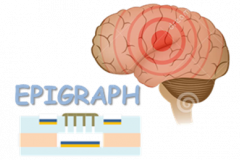
Brain function relies upon a complex, coordinated function of neurons, glial cells and blood vessels, which in neurological disorders such as epilepsy, Alzheimer’s, and Parkinson’s disease is disrupted. The EPIGRAPH project proposes the design and development of graphene biomolecular sensors, with graphene organic electronic ion pump (OEIP) neurotransmitter delivery, and electrophysiological electrodes integrated in an “all-in-one or single device/platform” for the prediction and control of epileptic seizures (towards a general intervention tool for most brain disorders). Specifically the main objectives are to: i) develop a graphene based biomolecular sensor for glucose and/or lactate detection using state-of-the-art laser processing techniques; ii) intervene pharmacologically to control brain activity via graphene-based OEIP electrophoretic drug delivery devices; iii) integrate the biomolecular sensor, the ion pump and the electrophysiological sensor into a single device that will enable combined electrophysiological and molecular measurements under in vitro/ex vivo (brain slice models) and in vivo environments (in situ animal model). The innovative function of this integrated single device is to provide treatment where and when it is needed. The “where” is provided by the local delivery made by the pump, and the “when” is provided by the molecular sensor if a predictive biomarker is found. EPIGRAPH will explore the potential of the device to provide local control of brain activity in vivo. A closed loop system will be developed that predicts and stops seizures in an animal model. Graphene provides an optimal foundation for this lab-on-a-chip as it provides flexibility, high-performance, bio-compatibility, etc. The addition of organic electronics provides a unique opportunity to add ion (and charged biomolecule) signalling to the bio-tech interface. In this project, we will address the current limitations in technology for interfacing with neural signalling using “organic neuroelectronics” – bioelectronic tools developed specifically for precise neurochemical interfacing – and provide more profound understanding of neural dynamics and better therapies for neurological disorders. The main challenge of such technology is to be able to generalize this device to a variety of brain disorders, to measure and intervene on brain function where and when it is necessary.
EPIGRAPH, a high-throughput medical device, will have a broad impact on different disciplines such as Neuroscience, Pharmaceutics, Bioelectronics, and Biomedical devices and also on the rapidly developing fields of biosensors, bioelectronics and GRMs. EPIGRAPH directly addresses the Flagship topic of Graphene-Applied Research and Innovation and in particular the specific area of 9. GRM based bioelectronics technologies. It is foreseen to fit with the scope of Work Packages 5 (on Biomedical Technologies) and WP6 (on Biosensors) of the Graphene Flagship Core Project.
Principal Investigator
Scientific Staff
Alumni
The EPIGRAPH project aims to integrate the biomolecular detection and actuation technologies based on graphene-related materials into a single device, and predict (with biomolecular sensing) and stop (with biomolecule delivery) seizure genesis/propagation in an experimental model of temporal lobe epilepsy.
To meet these challenges, we define the following general objectives:
-
To develop a graphene based biomolecular sensor for glucose and/or lactate detection using state-of-the-art laser processing techniques for better functionalization. We will focus on metabolic activity (glucose and lactate), because it is disrupted in neurological disorders, and because preliminary data indicate that slow changes in glucose/lactate may constitute a predictive biomarker of incoming seizures in epilepsy.
-
To intervene pharmacologically to control brain activity via graphene-based OEIP electrophoretic drug delivery devices. The pharmaceutical industry has developed powerful drugs to treat neurological disorders, but these drugs failed in the clinic for various reasons (toxic effects, deleterious side effects, and poor brain penetration). We have shown that this issue can be addressed with electrophoretic ion pumps, which were shown to deliver biomolecules directly into the brain region to treat and stop epileptiform activity in a brain slice model [2].
-
To integrate the biomolecular sensor, the ion pump and the electrophysiological sensor into a single device that will enable combined electrophysiological and molecular measurements under in vitro/ex vivo (brain slice models) and in vivo environments (in situ animal model). We plan to develop this technology for in vivo use to deliver large and/or aromatic molecules, which constitute most of the drugs developed by the industry. We will show that such devices can control brain activity, in particular seizures, which represents a major step beyond the current state-of-the-art.





